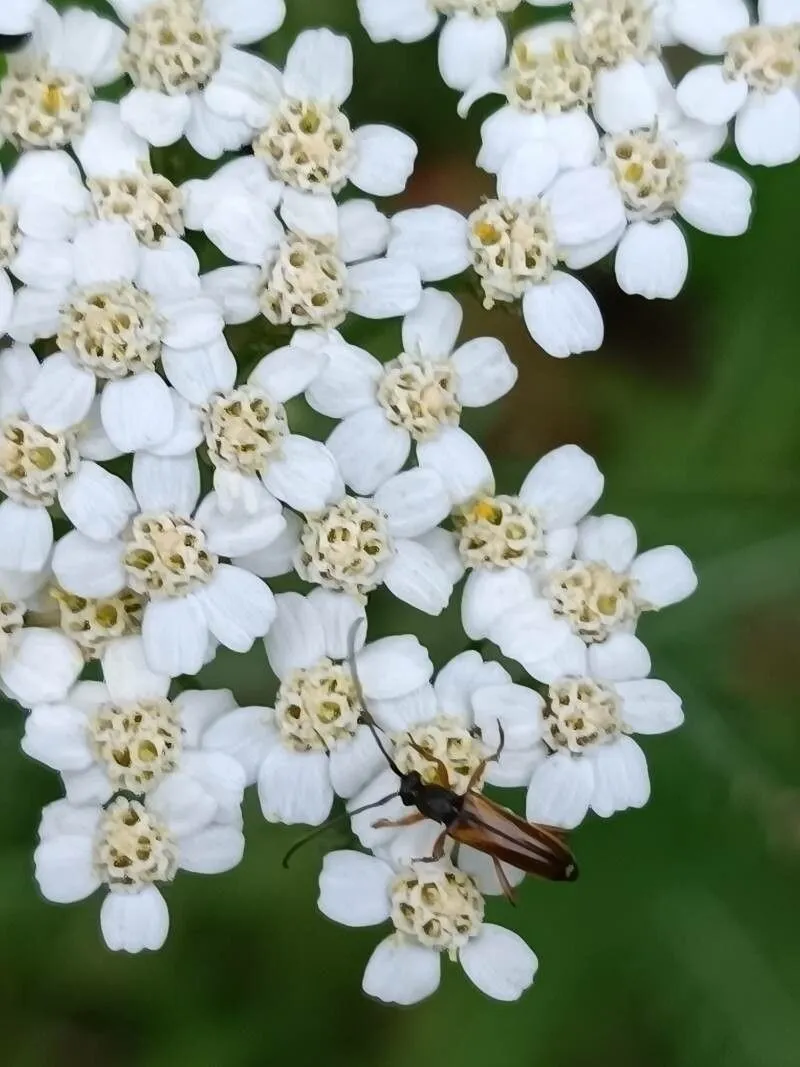
Author: L.
Bibliography: Sp. Pl.: 899 (1753)
Year: 1753
Status: accepted
Rank: species
Genus: Achillea
Vegetable: Unknown
Observations: Europe to Siberia and Caucasus
Noble yarrow, known scientifically as Achillea nobilis, is a perennial herbaceous plant celebrated for its medicinal properties and ornamental value. First described by the renowned botanist Carl Linnaeus in his seminal work, “Species Plantarum” in 1753, this species belongs to the diverse Asteraceae family.
Characterized by its finely divided, feathery leaves and clusters of small, often white or yellow flowers, Noble yarrow is a noteworthy presence in various habitats. It spans a wide geographical range, extending from Europe to Siberia and into the Caucasus region. The plant thrives in well-drained soils and is frequently found in meadows, grasslands, and open woodlands, preferring sunny locations.
Historically, Achillea nobilis has been utilized for its therapeutic qualities, believed to aid in wound healing and, historically, provide relief for several ailments. Its name, “Achillea,” is derived from the mythical Greek hero Achilles, who is purported to have used yarrow to treat his soldiers’ battle injuries.
In addition to its medicinal applications, Noble yarrow is popular in gardening and landscaping due to its hardiness and the visual appeal of its lush, green foliage and delicate flowers. It attracts a variety of pollinators, making it a beneficial addition to ecological gardens aimed at supporting biodiversity.
As a member of the Asteraceae family, it shares many characteristics with other yarrows, including a robust resistance to pests and a low maintenance growing habit, making it an excellent choice for both amateur and experienced gardeners. Accordingly, Noble yarrow represents the intersection of aesthetic beauty, ecological benefit, and historical significance.
Dan: blå-klokke, ensidig klokke, havepest, liden venusspejl, rapunsel-klokke, ædel røllike
Nor: blåklokke, ugrasklokke
Swe: dvärgspegel, knölklocka, liten blåklocka, rapunkelklocka, jalokärsämö, ängsröllika, ängsrölleka
Deu: edel-schafgarbe, edle schafgarbe
Fin: kauriinkello, kissankello, vuohenkello, jalokärsämö
Lit: kilnioji kraujažolė
Eng: noble yarrow
Lav: dižais pelašķis
Nno: engryllik
Nob: engryllik
Est: lõhnav raudrohi
Nld: edel duizendblad
En: Noble yarrow, Creamy Yarrow
Ar: قيصوم نبيل
Az: Nəcib boymadərən
Be: Крываўнік дабрародны
Bg: Благороден равнец
Cs: Řebříček sličný
Da: Blå-Klokke, Ensidig Klokke, Havepest, Liden Venusspejl, Rapunsel-Klokke, Ædel røllike
Nl: Edel duizendblad, Edel-Duizendblad
Et: Lõhnav raudrohi
Fi: Jalokärsämö, Kauriinkello, Kissankello, Vuohenkello
Fr: Achillée noble
De: Edle Schafgarbe, Edel-Schafgarbe, Edel Schafgarbe
It: Millefoglio nobile
Lv: Dižais pelašķis
Lt: Kilnioji kraujažolė
No: Blåklokke, Ugrasklokke
Nb: Engryllik
Nn: Engryllik
Fa: بومادران نجیبزاده
Pl: Krwawnik szlachetny
Ru: Тысячелистник благородный
Sv: Ängsröllika, Dvärgspegel, Knölklocka, Liten blåklocka, Rapunkelklocka, Jalokärsämö, Ängsrölleka
Tr: Ayvadana
Uk: Деревій благородний
Taken Sep 8, 2021 by ilve (cc-by-sa)
Taken Nov 23, 2021 by florian badey (cc-by-sa)
Taken Jun 24, 2021 by Else Nolden (cc-by-sa)
Taken Nov 20, 2021 by Jardin Des Cocagnous (cc-by-sa)
Taken May 31, 2022 by Alain Lagrave (cc-by-sa)
Taken May 31, 2022 by Alain Lagrave (cc-by-sa)
Taken Nov 28, 2021 by Daniel Da Parigi (cc-by-sa)
Taken Nov 26, 2021 by Gary Glanz (cc-by-sa)
Taken Jul 2, 2021 by Herman Rombouts (cc-by-sa)
Taken Mar 18, 2022 by Unisonne Unilachen (cc-by-sa)
Taken Jun 12, 2022 by Ghost A (cc-by-sa)
Taken Jan 1, 1970 by Photoflora – L’Abbé COSTE (©)
Taken Jun 29, 2021 by Silje Miriam (cc-by-sa)
Taken Nov 3, 2022 by Trap Hers (cc-by-sa)
Taken Jun 5, 2021 by Thierry LE COM (cc-by-sa)
Taken Apr 14, 2022 by William Coville (cc-by-sa)
Taken Jul 25, 2022 by Jean-Louis C. (cc-by-sa)
Taken Sep 3, 2021 by Jacques Zuber (cc-by-sa)
Taken Nov 28, 2021 by Daniel Da Parigi (cc-by-sa)
Taken Dec 21, 2021 by Daniel Da Parigi (cc-by-sa)
Taken Sep 4, 2022 by pesola marta (cc-by-sa)
Taken Jun 26, 2021 by Bela Borbely (cc-by-sa)
Taken Nov 8, 2021 by Pat (cc-by-sa)
Taken Nov 26, 2022 by pabloro (cc-by-sa)
Taken Oct 9, 2021 by cscoq (cc-by-sa)
Taken Nov 1, 2022 by Caw Vus (cc-by-sa)
Taken Oct 8, 2021 by cscoq (cc-by-sa)
Taken Jun 15, 2022 by Wouter de Croon (cc-by-sa)
Taken Jul 26, 2021 by natanaelo (cc-by-sa)
Taken Oct 20, 2022 by geronimo57 (cc-by-sa)
Family: Myrtaceae Author: (F.Muell.) K.D.Hill & L.A.S.Johnson Bibliography: Telopea 6: 402 (1995) Year: 1995 Status:…
Family: Rubiaceae Author: Pierre ex A.Froehner Bibliography: Notizbl. Bot. Gart. Berlin-Dahlem 1: 237 (1897) Year:…
Family: Sapindaceae Author: Koidz. Bibliography: J. Coll. Sci. Imp. Univ. Tokyo 32(1): 38 (1911) Year:…
Family: Asteraceae Author: A.Gray Bibliography: Pacif. Railr. Rep.: 107 (1857) Year: 1857 Status: accepted Rank:…
Family: Fabaceae Author: Medik. Bibliography: Vorles. Churpfälz. Phys.-Ökon. Ges. 2: 398 (1787) Year: 1787 Status:…
Family: Aspleniaceae Author: (Cav.) Alston Bibliography: Bull. Misc. Inform. Kew 1932: 309 (1932) Year: 1932…